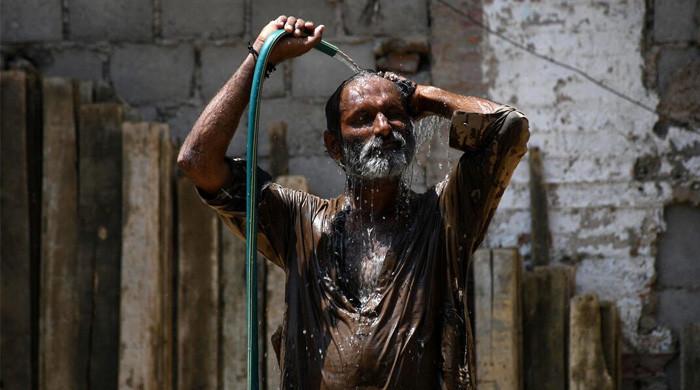Lahore: For the second consecutive year, April in Pakistan did not arrive with a flowering, but with scorching heat. Through large strips of Punjab, Sindh and Baluchistan, temperatures rose more than 40 degrees Celsius, weeks before the official summer start.
“In the last two years, Pakistan has not experienced spring,” Muhammad Irfan Virk, deputy director of the Pakistan Meteorology (PMD) in Islamabad told Islamabad The news. “April is becoming warmer and more hot. This is worrying.”
The PMD issued five heat notices in April and May of this year, most of them in April, generally considered a month of transition. The hottest day was recorded on April 17, in the district of Shaheed Benazirabad of Sindh, where Mercury hit 49 C.
According to the summary of the monthly PMD climate, April 2025 was the second most warm April in the last 65 years: the highest was in 2022. And both in May 2024 and 2025, temperatures increased from 4 to 6 C above long -term averages in several areas, the National State Disaster Management Authority reported (NDMA).
“This marks a worrying trend, indicating that future heat waves can become even more intense due to continuous climatic changes and anthropogenic factors,” the NDMA wrote in its annual publication of 2024.
The extreme heat was not limited to Pakistan. An Climameter report, an international platform that tracks extreme climatic events, discovered that both Pakistan and India experienced an “early arrival of the heat wave.”
“The heat wave in both countries is disproportionately impacting the vulnerable sectors of the population and is severely tested the general human limits, pushing the thresholds for survival,” the report said.
The report highlighted Islamabad as one of the most affected cities, with average temperatures of up to +3 C higher than in previous years.
This trend is aligned with the findings of an analysis of three decades by the World Wildlife Fund (WWF) Pakistan, which links rapid urbanization in the capital city of Pakistan with the increase in temperatures of the earth’s surface.
“In Islamabad, rapid urban growth has replaced farmland, grasslands and forests, which makes it one of Pakistan’s greatest expansion cities,” said the WWF report. “The built area of Islamabad shot at almost 585%, while the tree cover received a 10% success between 1990 and 2020”.
A similar urban expansion and loss of vegetation in Lahore and Karachi have been documented.
The NDMA administered by the Government had similar findings. An NDMA spokesman said The news That while the districts of the southern Punjab, Sindh and Baluchistan remain the climate critical points, urban centers are warming faster. “Lahore, Karachi and Islamabad are heating at a higher rate due to the effect of urban heat island,” he said.
David Faranda, a senior climate scientist of the National Center for Scientific Research of France and co -author of the Climameter report, believes that the disappearance of spring indicates a deeper climate change in southern Asia.
“The loss of a ‘shock absorber’ season as spring reflects how extreme climatic patterns are replacing gradual seasonal changes, especially in vulnerable regions such as southern Asia,” he said. “Heat waves should be treated not only as weather events but as public health emergencies.” But Pakistan’s current systems are far from being equipped to do so.
In May, Climate Change Minister told the National Assembly that 568 people died in Pakistan during a six -day heat wave between June 20 and 26 last year. Of these, 427 were only Karachi.
However, when The news He contacted the Federal Ministry of Climate Change, the PMD and the NDMA, none of the organizations could provide updated figures for deaths or heat -related diseases. The number presented in Parliament, admitted, officials in private, came from non -profit organizations, added that there was currently no mechanism to collect such figures.
A government official, who asked not to be appointed, recognized the gap. “These data must be collected. People must be sensitized to how serious this [heatwaves] The problem is, ”he added.
Pakistan contributes less than 1% of world emissions of greenhouse gases, but remains among the ten countries most vulnerable to climate change. Floods, droughts, flood floods of the glacial lake, and now increasingly frequent and intense heat waves threaten the safety of food and water and millions of livelihoods.
And the changes are not limited to the increase in heat. In April, Islamabad was mistreated by a sudden and violent hail storm, described by residents as an ‘monster’ event, which damaged cars, houses and public infrastructure.
While the causes are global, national planning decisions are also exacerbating local impacts, said Hammad Naqi Khan, WWF Pakistan CEO.
“We are creating heat islands in our urban areas. We are eliminating the vegetation and coverage of LaHore trees to Islamabad to Karachi, Murre,” he said. “Yes, Pakistan’s contribution to emissions is very low, but also needs to put his own home in order.”
Khan urged federal and provincial governments to develop specific thermal action plans of the city and train local governments to implement them.
Faranda agrees. He pointed out that some cities, such as Ahmedabad in India and Seville in Spain, now name heat waves to create public awareness and frame them as serious threats.
In 2022, Seville named the first heat wave in the world: Zoe.
Faranda also suggested to name “heat officers” dedicated to guarantee coordination between government agencies during extreme climatic events.
In addition, he asked for climate diplomacy among Indian archirrival and Pakistan to save lives.
“Heat waves do not recognize borders. Regional cooperation in data exchange, prognosis, public health strategies and urban resilience could save thousands of lives,” Faranda said. “In a fragmented world, the climatic crisis could become a bridge for humanitarian pragmatic collaboration.”




